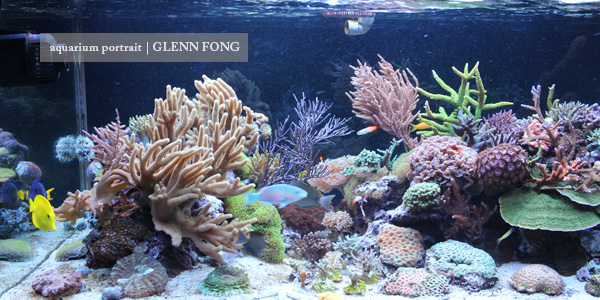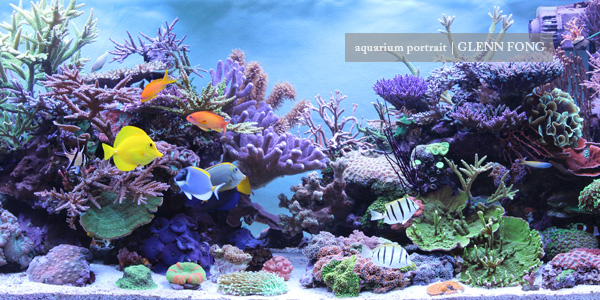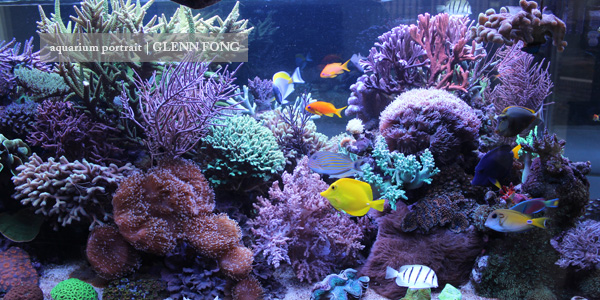Dutch Synthetic Reefing
Rules? What rules? An aquarist in the Netherlands
finds unconventional success without water changes
aquarium portrait | GLENN FONG
The Dutch Synthetic Method (DSR) is a revolutionary approach to marine aquarium keeping that challenges the conventional wisdom of mimicking natural seawater parameters and performing frequent water changes. Instead, DSR advocates for creating a synthetic seawater environment that is tailored to the specific needs and preferences of the corals and other reef inhabitants. DSR relies on precise measurements and adjustments of various chemical elements, such as calcium, magnesium, alkalinity, nitrate, phosphate, and trace elements, to achieve optimal water quality and stability. DSR also minimizes the use of equipment, such as skimmers, reactors, and dosing pumps, to reduce costs and maintenance.

Until I contracted the Human Saltwater Virus in December 2004, my current 370-gallon (1,400-L) aquarium was a freshwater tank inhabited by Malawi cichlids. After a lifetime of keeping freshwater aquaria, I dove headlong into something totally new. I removed the fishes, drilled a hole in the bottom of the tank, plumbed a sump into the system, and filled the tank with salt water. Thus began my marine adventures and my unorthodox route to a thriving reef aquarium a decade later.
From the start I never did water changes—I had not changed the water in my freshwater tanks either. I started with the usual soft corals, a few large-polyp stony corals, and some easy small-polyp stony corals. I built my own skimmer and calcium reactor, and for a while all went quite well—until I start putting more demanding small-polyp corals into the tank.
In 2008 I lost a few stony corals due to an inadequate calcium reactor that could not keep up with the corals’ appetites, so I built a larger one and introduced new SPS corals. Then, at the end of 2010, I lost the majority of my stony corals when multiple things went wrong: a reverse osmosis unit stopped doing its job, the calcium reactor started acting up, and a 130-gallon (500-L) tank of nonphotosynthetic (NPS) corals that I had connected to my reef started crashing. In retrospect, I realized that the NPS tank was a mistake: on top of the calcium problem, I had a sky-high phosphate level (0.64 ppm) in my reef tank. I was so discouraged that I decided to give up the hobby. I left the tank running with minimal care and went on a 30-day vacation to Thailand in mid-2011.

In November 2011, I decided to give it another try. This time I was determined to do it right. After reading about water chemistry I chose to make my own reef salt. To test my results, I filled a 2.6-gallon (10-L) fishbowl with my own saltwater blend and added some small frags. I was pleasantly surprised when I noticed some growth in this little tank, so after two months I replaced 118 gallons (450 L) of water in the big neglected reef tank with my own synthetic salt water. (This water had not been changed since 2004). I chose to do the water change because I could not lower my phosphate level, which remained between 0.16 and 0.64 ppm, with granular ferric oxide (GFO). The synthetic water contained no phosphate, so adding it diluted the phosphate concentration. This was just enough to reverse the downward spiral that had begun, and I started stocking the reef with SPS and LPS coral frags again.
During the following six months I start measuring and controlling as many parameters as possible using the minerals I used to compose the synthetic salt. All went well, and my phosphate and nitrate levels sunk to being unmeasurable. After a while, however, some corals were growing and others turning pale. Eventually all of them turned pale, started to bleach, and lost tissue from the bottom up. I nearly lost a complete colony of Green Birdsnest Coral, Seriatopora caliendrum. There were only a few branches left, which I fragged and mounted on a small rock. After a long while I decided this was not the way to go, so I started dosing the reef tank with phosphate (0.08 ppm) and nitrate (2.5 ppm).

This was a valuable lesson: that you can actually take nitrate and phosphate levels too low. To my surprise, all of the corals regained their polyps and color and started growing again. For a while I was playing with the phosphate and nitrate levels to see what worked best and noted that corals reacted differently to different levels. I decided that controlling phosphate and nitrate, as well as the other parameters, was the key to success. Between January 2012 and today I have fine-tuned my water parameters and learned a lot about corals and their needs.
I call my method of keeping a reef without water changes the Dutch Synthetic Reefing method, and I now market a line of reef supplements under the DSR Technics brand.
DISPLAY TANK: Custom built, 8 x 2.6 x 2.3 feet (2.5 x 0.8 x 0.7 m) (60 cm WH)
STAND: Self-built and welded with steel stock
SUMP: Single compartment, 30 x 17 x 26 inches (75 x 42 x 65 cm) (water height 5 inches/13 cm)
PROTEIN SKIMMER: Using an old Shuran skimmer as a base, I modified it to run on four wooden air stones driven by a Velda Silenta Pro 1800 air pump.
— I use a 150 mg/h ozone reactor connected to a mV controller, which is dosed through the skimmer.
— Zeolite reactor for breeding bacterioplankton to feedthe corals; shaken once a week only.
— 18W UV lamp
CARBON/PHOSPHATE FILTRATION: No use of carbon, GFO, or bio-pellets. Self-built zeolite reactor filled with pond zeolites.
RETURN PUMP: Royal Exclusiv RED DRAGON 6500 (1,717 gallons/6500 L/h) with filter wool on the intake, cleaned every 3–5 days.
WATER CIRCULATION: 3 Tunze 6100 (3,170 gallons/12000 L/h) connected to an IKS computer.
LIGHTING: Self-built 10x T5/54W and 4x T5/39W placed 4 cm above the water surface and enclosed within the tank cover panels.
CA/ALK/MG DOSING: I use DSR, my own method, with no water changes. (To learn more about DSR you can visit my website, which is still in development: www.dsrreefing.nl.)
I use an Aqua Medic KR1000, which is way too small for this system, so I use it as a backup system. If needed, I dose supplements that I make myself.
Manually: Phosphate, nitrate, boron, potassium, magnesium (measure and correct). On dosing pumps: Aqua Medic reef doser 2 channel for alk and calcium; IKS 4 channel for iodide, iron, carbon V/S, strontium.
ATO: DIY automatic water filler that uses a siphon and gravity from a 13-gallon (50-L) tank placed in the bathroom.
RO/DI: Simple 99-gallon (375-L) per day three-step RO device with an additional silicate filter, turned on daily by a garden timer to replenish evaporation.
HEATING/COOLING: Room temperature is set at 70°F (21°C). I use a 300W thermostatic heater in the sump, no chiller, only 10x 8 x 8-cm 12-volt fans mounted on the tank cover to blow cool air through the lamps and surface and remove heated air from the tank.
SYSTEM CONTROLLER: IKS Aquastar that controls lighting, 3x Tunze 6100 streamers, 4-channel dosing pump, water level alarm. Also measures temperature, pH tank, pH calcium reactor, redox.
WATER CIRCULATION & FLOW SUMMARY: All three Tunze 6100s are connected to the IKS computer with an interval timer and simmod for modulation and are programmed to randomly power on and off to create random streaming patterns. Because of the random pattern I never know how many pumps are active; it could be one, two, three, or none.
WATER PARAMETERS (PARAMETER, MEANS OF TESTING)
• Temp: 77–79°F (25–26°C), digital ear thermometer
• pH: 7.95–8.20 night/day max. variation
• Salinity: 34–35 ppt, refractometer
• Ammonia: not measured
• Nitrate: 1–2.5 ppm, Salifert nitrate test kit
• Nitrite: not measured
• Phosphate: 0.04–0.08 ppm, Red Sea phosphate test kit
• Calcium: 440 ppm, Salifert calcium test kit
• Alkalinity: 8–9 KH, Salifert KH test kit
• Magnesium: 1350 ppm, Salifert magnesium test kit
LIGHTING SUMMARY: Photoperiod: Blue bulb nr 4/4.1 turns on at 9:30 am, off at 10:30 pm. All others turn on at 10:00 am, off at 9:30 pm. Bulbs are replaced after about 12 months of use.
FILTRATION & WATER QUALITY SUMMARY & OBJECTIVES: No structural water changes since 2004. DSR method used to add supplements and reduce nutrients. FISHES: 2x Amphiprion ocellaris, Pterapogon kauderni, Oxymonacanthus longirostris, Zebrasoma flavescens, Z. xanturium, Naso lituratus, Acanthurus leucosternon, A. lineatus, A. tenetti, 3x A. triostegus, Ctencheatus tomini, C. striatus, C. binotatus, C. strigosis (juvenile in frag tank), Salarias fasciarus (in frag tank), S. ramosus, Scarus quoyi, Atrosalarias fuscus, Synchiropus splendidus pair (m/f), S. ocellatus pair (m/f), 2x Ecsenius stigmatura, Meiacanthus atrodorsalis, Amblyeleotris wheeleri + symbiotic shrimp, Halichoeres chrysus, Macropharyngodon ornatus, 3x Pseudanthias squamipinnis, 6x P. dispar, P. evansi, 3x Chromis viridis.
INVERTS: 6x Lysmata amboinensis, 2x Enoplometopus debelius, Turbo fluctuosa (Mexican Turbo Snail) with countless offspring, Astraea tecta (Turbo Snail ) with offspring, 4x Tripneustes gratilla (Pincushion Urchin), Echinometra sp. (Shortspine Urchin), Diadema setosum (Longspine Urchin, Black).
CORALS: 182 species of corals and invertebrates, some that have not been clearly identified.
OWNER: Glenn Fong, Rotterdam, The Netherlands
Dutch Synthetic Reefing (DSR): www.dsrreefing.com
This article is outdated as the method has improved since then. There are now four different ways to dose DSR and the equipment needed is minimal. The main filter is a DSRpowerfilter that works with a dosing computer to add the daily supplements and the old T5 lights have been replaced by LED lights.